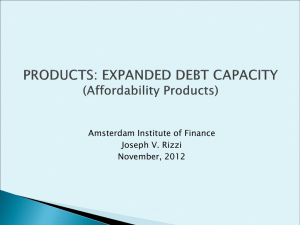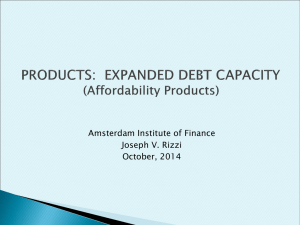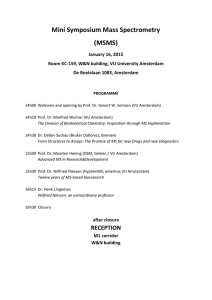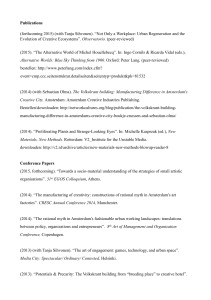AIF_Products_Expanded_Debt_Capacity_June 2010
advertisement
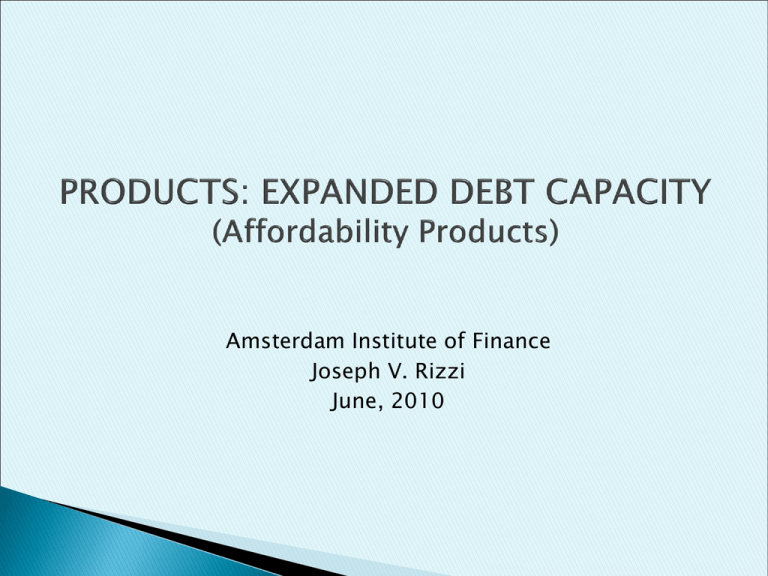
Amsterdam Institute of Finance Joseph V. Rizzi June, 2010 Rising purchase price multiples and ROE concerns drove acquirers to seek ways to expand their debt capacity. Some of the most common techniques are: Adjusted (Increased) EBITDA - Operating improvements - Normalization Asset Sales - Bridges to asset sales - Liquidity is key in case bridge cannot be taken out Innovative Securities - Defer interest - Push out amortization - Increase flexibility Amsterdam Institute of Finance June, 2010 2 Term Amortization Covenant Call Seniority Secured Revolver 5–7 Bullet FULL YES YES YES Term Loan A 5–7 40% in first 5 years FULL YES YES YES Institutional Term Loans 7-8 1% per annum / bullet FULL YES YES YES Covenant Lite 8 - 10 1% per annum / Bullet LIGHT PREMIUM YES YES Mezzanine 10 + Bullet LIGHT PREMIUM NO Depends High Yield 10 + Bullet LIGHT PREMIUM NO NO Holding Company PIK 10 + Bullet LIGHT PREMIUM NO NO Bridge Term Loans 1-3 Bullet FULL YES YES YES Securitization 1-5 Revolver with Borrowing Base FULL YES YES YES Second Lien 8-9 Bullet FULL YES YES YES Bifurcated Lien (cross lien) 8-10 1% P.A./Bullet Yes Yes Yes Partial Unsecured 1-10 1% P.A./Bullet Yes Yes Yes No OPCO/PROPCO 10+ Bullet Yes Yes Yes Yes The above table shows the features of different debt options available to issuers The availability of the different options is subject to market conditions Amsterdam Institute of Finance June, 2010 3 Innovative securities allow for the expansion of debt capacity by one or more of the following mechanisms: Reduce Annual Debt Service - Reducing cash interest expense - Lengthen duration (Reduce/Delay amortization) Increasing Flexibility - Covenants - Cash flow control - Bridging - Public Disclosure - Call Premium - Partial/fully Unsecured Tranching (sequential ordering of payment or priorities) - Holding Company instruments - Restricted Subsidiaries - Second lien/bifurcated collateral-crossing liens - Senior/Subordinated Cost – Second Lien vs Mez Amsterdam Institute of Finance June, 2010 4 Amsterdam Institute of Finance June, 2010 5 Amsterdam Institute of Finance June, 2010 6 Senior Secured, but with Junior or Second Lien ◦ Higher default ◦ Lower recovery Originally developed as Rescue Finance Competing with EURO Mezzanine ◦ Investors – hedge funds and CLO Formerly Attractive Pricing: Spread differential between Second Lien and First Lien 350 BP. Issues: - Inter-creditor - Standstill Agreement - Obligations - New Investors Behavior in a Workout - CLO Rating Impact Amsterdam Institute of Finance June, 2010 7 Amsterdam Institute of Finance June, 2010 8 Amsterdam Institute of Finance June, 2010 9 Covenant Issues ◦ Creditor – preserve deal; recovery value ◦ Debtor - flexibility Covenant Lite – liquidity vs. structure ◦ Similar to Investment Grade ◦ One or No Financial Covenants Rating Agency impact on CLO Volume ◦ US 1H07 – 104B (35% of loans) 3H07 – Virtually 0 ◦ Europe – Shut down 1Q08 difficult Amsterdam Institute of Finance June 2010 10 Amsterdam Institute of Finance June, 2010 11 By structuring the financing of a pool of assets with a credit quality stronger than the corporate credit as a whole, ‘OpCo’ \ ‘PropCo’ financing can provide a cost effective source of (acquisition) financing. Example:◦ Target company de-merged into ‘PropCo’, which owns the real estate assets, and ‘OpCo’, the operating company. ◦ Banks finance ‘PropCo’ acquisition of properties at agreed Loan to Value ratio. ◦ ‘PropCo’ leases the real estate assets to ‘OpCo’. ◦ ‘PropCo’ debt refinanced by traditional Property Lenders or via Commercial Mortgage Backed Securities (CMBS) market. ◦ ‘OpCo’ required to service the acquisition debt not assumed by ‘PropCo’. Amsterdam Institute of Finance June, 2010 12 ‘OpCo \ PropCo’ Financing (2) BidCo Financing Approx. 100% Notes Approx. 100% OpCo PropCo Rental Payments Amsterdam Institute of Finance June, 2010 13 Requirements: ◦ Stable and resilient cash flows from business ◦ Control over cash flows through sale of assets or adequate legal structure ◦ Target investment grade rating to maximize access to investors and lower cost of capital Different leverage measurements Issues ◦ Favorable bankruptcy laws ◦ Inter-creditor issues ◦ Flexibility Closed: 2H07 to present Amsterdam Institute of Finance June, 2010 14 • Longer Term Bonds 7-10 years and longer 4/5 NC • Public or Private Usually issued in private form with exchange rights Pricing would step up if bonds not public within short period (say 180 days of close) • Usually issued as subordinated debt but can also be senior unsecured • Markets US - $871B size Euro - €65B size Amsterdam Institute of Finance June, 2010 15 • Registration Rights Amsterdam Institute of Finance June, 2010 16 Key High Yield Terms • Registration Rights • Issuer • Status • Degree of Subordination • Limitations on liens • Limitations on indebtedness • Restricted payments • Asset sales • Change in control Amsterdam Institute of Finance June, 2010 17 Covenants * * Extensive (bank type) Maintenance basis (tested quarterly) Security * Second secured Call Provisions * Generally callable immediately (103,102,101) Maturity * Ten year Pricing * * LIBOR + 800 bps (400 cash, 400 PIK) Warrants for total return (15-17%) Liquidity * Low Disclosure: * Limited Marketing * No research coverage, no roadshow Rating Requirements * None Amsterdam Institute of Finance June, 2010 18 Trend: Increasing segmentation of loans with reduced covenant or collateral ◦ ◦ Percentage of institutional loans with impaired covenants or collateral 1H07 47%, 2H07-Nil 2006 24% Breakdown 2007 1H07 47% 11% Second Lien 6.4% Bifurcated 23% 7% Covenant Lite Unsecured Bifurcated/Crossing Liens – See HCA for an example ◦ ◦ ◦ ◦ Asset backed revolving credit backed by first lien or receivables and inventory Term loans back by lien on other non-current assets Property, plant and equipment Stock pledge Pricing premium – 100 bps compared to revolver Inter-creditor complications Amsterdam Institute of Finance June, 2010 19 PIK •Pay if you can toggle •Eats up equity •Characteristics PIK Amsterdam Institute of Finance June, 2010 SLL Spread 825/900 500 Toggle 900-1000 Term 7.5-10 9.5 Call 5xNC n/a Leverage 6.5x+ 6x+ n/a (Source: LCD) 20 Stapled Financing Staple financing term sheet to deal book Be prepared to fund Establishes ceiling Conflicts of interest Amsterdam Institute of Finance June, 2010 21 Bridge Loans Equity ◦ Bank provides equity Find other equity investors later or keep Reduce PE equity Lowers need for club or larger deals ◦ Rationale – pay to play ◦ Bonds Amsterdam Institute of Finance June, 2010 22 Increasing layers of debt Directed at different investors Intercreditors conflicts 2006 – 1H07 • Common equity • Hybrid preferred (0.5x) 2004 + 2H07 - Present • Common equity • Unsecured/mezzanine (1x) • Senior secured bank loan (4x) - Amortizing T/LA – 40% - B/C tranches – 60% FDX – 5x + PPX – 7.5 + • PIK notes (0.5x) • Unsecured/mezzanine (1x) • Carve-out collateral (1x) - securitization - OPCO/PROPCO • Second lien loans (1x) • Senior secured bank loan (4x) - Amortizing T/LA – 20% - B/C tranches – 80% Amsterdam Institute of Finance June, 2010 FDX – 6x + PPX – 8.5 + 23 HCA ◦ ◦ ◦ ◦ ◦ – 33 bln USD (corp rating B2/B+) FDX – 6.53x (LTM) PPX – 7.7x Club – Bain, KKR, ML (5 bln) W/W – BofA, JPMC, Citi, ML Debt Package 1st Lien Term - R/C 2.000 bln 6 250 0 - ABL 2.000 bln 6 175 0 - T/LA 2.250 bln 6 250 50% - T/LB 9.300 bln 7 250 7% - EUR T/L 1.250 bln 7 250 7% 2nd Lien Spread Amortization (3.46x) (cum. At maturity) (1.33x) - Cash 4.200 bln 8 9.75% 8% - PIK/T 1.500 bln 8 10.0 % 8% Existing unsecured Equity ◦ ◦ 7.470 bln 2009 4.965 bln -- 7.5 % -- --- EBITDA/I – 1.9x (2007E) EBITDA – CAPEX/I – 1.1x (2007E) Amsterdam Institute of Finance June, 2010 24 HCA Legal Structure Sponsors Management Healthtrust Holdings Equity Merge Acquisition Corp HCA, Inc Bank Loans Existing Notes Euro T/L European subs Sub A Unrestricted subs Amsterdam Institute of Finance June, 2010 Sub B Sub C Sub D Sub E Restricted subs (gurantors) 25 Disclosure This information has been prepared solely for informational purposes and is not intended to provide or should not be relied upon for accounting, legal, tax, or investment advice. The factual statements herein have been taken from sources believed to be reliable, but such statements are made without any representation as to accuracy or completeness. Opinions expressed are current opinions as of the date appearing in this material only. These materials are subject to change, completion, or amendment from time to time without notice and CapGen Financial is not under any obligation to keep you advise of such changes. All views expressed in this presentation are those of the presenter, and not necessarily those of CapGen Financial. Amsterdam Institute of Finance June, 2010 26


